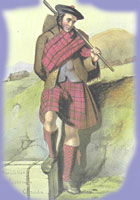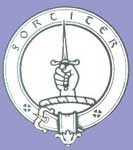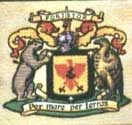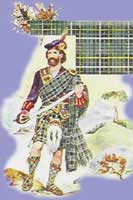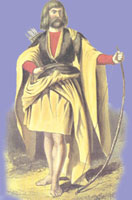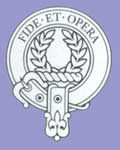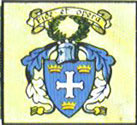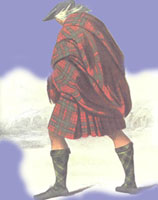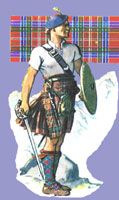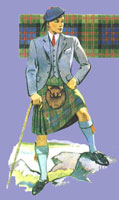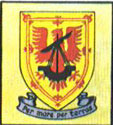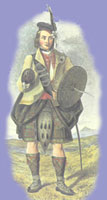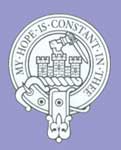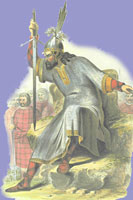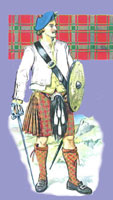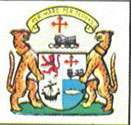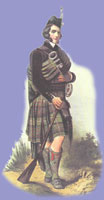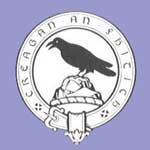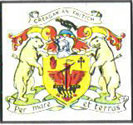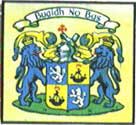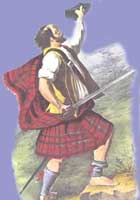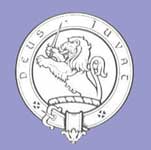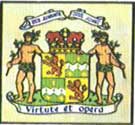Click below to find other Scottish Clans
|
|
|
This clan traces a direct descent from the early Lords of the Isles. Alistair Mor, Lord of the Isles and Kintyre, a contemporary of King Alexander III, is the progenitor of the MacAlistair line. An opponent of Robert the Bruce, he was imprisoned in Dundonald Castle on the Clyde and died there. His titles and estates were given to his brother Aongus who had supported the Bruce during the Wars of Independence .
The Macalistairs came truly into their own when James IV stripped the Lord of the Isles of his title in order to assume it himself. From then on, Ardpatrick in South Knapdale , Argyllshire, became the clan's home. By 1515, the chiefs were referred to as Vic-Ian-Dhu MacAlistair of the Loup. |
|
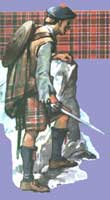 |
During The turbulent times of the sixteenth and seventeenth centuries the MacAlistairs of Kintyre spread into the neighbouring islands of Bute and Arran . During this time one of the cadets became the hereditary Constable of the royal castle at Tarbert which is between the Loup and Loch Fyne, the actual key to Kintyre is having access to the Loch .
Some of the MacAlistairs settled in a place called Clackmananshire, and built their homes in Menstrie, this land was held from the Earls of Argyll. Some of the clans people changed their name to Alexander, and although they still claimed their progenitor was Alasdair Mor they also knew that Alasdair is the Gaelic for Alexander. |
Sir William Alexander MacAlistair of Menstrie, created Earl of Stirling by King James VI, persuaded James VI to found the Baronets of Nova Scotia .
In 1645, the clan fought on the side of Montrose and Charles I at Inverlochy, even though the Marquis of Argyll had convinced the clan chief, Hector, not to be present. Ever loyal to the Stewarts, the clan fought again, this time on the side of Bonnie Dundee, at the battle of Killiecrankie in 1689. Alasdair eighth of the Loup also fought the following year at the battle of the Boyne . This was a devastating defeat for the Jacobites and it took them many years to recover from it. They had fought well at the Boyne but William the third with the financial backing of the Pope was able to buy Catholic mercenaries from all over Europe to aid him in his usurpation of the British crown.
MacAlistair of the Loup is the present chief and Menstrie Castle, by Stirling, the clan seat. The clan plant is the heather.
|
Chief: MacAlistair of Loup
Clan Seat: Menstrie Castle by Stirling
Plant: Heather (ling)
Memorials : None |
|
|
| Back to Top |
Traditionally, the ancient home of this clan was Dunstaffnage, near Oban. A descent from King Alpin is claimed but has never been proved. However, the clan's early crest was the royal boar of the early Kings of Scots in Dalriada.
The origin of this clan stems from a confederation of clans who got together in order to counter-balance the influence of Clan Chattan. Disagreeing upon various inaugural matters, the confederation came to nothing.
There is very limited resources concerning this clan and after much searching have not found another relevant detail worth passing on. |
|
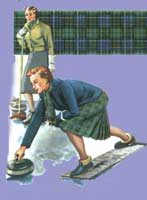 |
The only other thing I could find was that an Edith MacAlpine who was born 1725 married an Archibald MacGregor who was born in 1721, Archibald allegedly fought for the Jacobite cause at the battle of Culloden when Charles Edward Stuart (Bonnie Prince Charlie) led his Jacobite army to defeat at the hands of the Government troops led by Cumberland . When the battle had finished many Scots wounded were murdered by the government troops as they lay helpless in the heather.
There was a nationwide hunt for all Scots who had taken part in the Jacobite cause to replace the Hanoverian usurpers with the true monarchy of Scotland . |
| Many Scots fled abroad including Archibald MacGregor. He and his wife emigrated to America where they produced a daughter Anne in 1756. |
Chief: Not Known
Clan Seat: Not Known
Plant: Not Known
Memorials :Not Known |
|
| Back to Top |
Of Celtic origin, the Macarthur's were the hereditary pipers to the MacDonalds, Lords of the Isles. People have tried to claim that the family are in some way connected to the legendary King Arthur but that has never been proven without doubt. It is also thought that the name may derive from the Greek word Arktouros; meaning ‘keeper of bears' or as strong as a bear' There was a King Arthur in the sixth century who was a great Celtic Chief who had a son and called him Arthur, but it was written down as' Aedan MacGabhrain',
There is an old Scottish saying: “As old as the hills, the Macarthur's, and the devil”. The family are undoubtedly very ancient in the realms of Scottish history. |
|
 |
One of the Macarthur's married into the Campbell family when he took his wife from the Campbells Lords of Loch Awe. The MacArthur family clan supported Robert the Bruce during the Wars of Independence and were granted the forfeited estates of John MacDougall, Bruce's fiercest opponent in the Highlands . The MacArthur clan had been with King Robert the Bruce right through the hardest times when him and William Wallace the other great Scottish Patriot, fought the English for the right to have a free Scotland . This lasted until the Twenty-fourth day of June 1314 when The Bruce defeated Edward the second of England at the famous Battle of Bannockburn and regained Scotland 's pride as an independent nation. |
King James the first, however, was attempting to subdue the Highland clans and unfortunately for them the Macarthur's bore the brunt of his attacks. The King had the MacArthur beheaded and forfeited his lands. Later, the family was able to obtain a part of Strachur, in Cowal, Argyllshire, and would later own a portion of Glenfalloch and Glendochart. The family clan survived but never did regain their homelands nor the clan unit ever again. The MacArthur name is still very well known around the world to the present day but they have no real place to call home at this moment in time.
The beautiful but very dangerous, Loch Awe has been an inspiration to many of the Macarthur family and they were known to be experts at boating and seamanship. Many times the family clan would have died of hunger if it had not been for the ‘Fruits of the Loch ' The Loch was their protector and their benefactor too.
The MacArthur family with their tradition of Bagpipe players would play in the evenings and the beautiful melodies would float over the darkened Loch . There are people to this day swear that in the evening if the wind is still you can hear a piper playing across the Loch. |
Chief: MacArthur of Tirracladdich
Clan Seat: Tirracladdich, on Loch Awe
Plant: Wild Thyme
Memorials: None |
|
| Back to Top |
| Of Celtic origin, it is difficult to fathom who the progenitor of this clan was. Ardincaple Castle, Row, in Dunbartonshire, was originally the clan seat. Since they also dwelt in Kintail, some historians believe that they may be connected to the Earls of Lennox . Certainly, the name of Aulay, brother of Malduin, Earl of Lennox (a contemporary of King Alexander III), is mentioned in many charters as a witness. Aulay's son Duncan was also known as ‘MacAulay, Knight'. By 1587, Sir Aulay MacAulay was enrolled as one of the chief vassals to Charles, Earl of Lennox , the brother in law of Mary, Queen of Scots. |
|
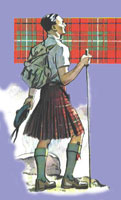 |
It is a matter of record that the MacAulay family signed the “ Rag Mans Roll” in the year of 1296. By signing this document they were swearing allegiance to Edward the first the hammer of the Scots. He had forced the Chiefs and Peers of Scotland to attend Berwick to sign their loyalty to him. Edward had slaughtered the whole town and left the bodies on the streets as a warning to any rebellious Scots.
This was put to rights when King Robert the Bruce (who had signed the rag mans roll) defeated Edwards son at the battle of Bannockburn on the twenty-forth of June 1314. |
Scotland 's honour was restored for many years.
On the twenty-seventh of May 1591 the MacAulay's of Ardincaple entered into a bond with MacGregor of Glenstrae. It would be a Manrent and Deed of Clanship bond. This charter gave the MacAulay Clan the protection that they required by being associated with a larger Clan. The MacAulay family had to pay a tribute every year to their superiors this was called a “Calp” and was very much the Highland way of life. This tribute was cattle to be brought to a place predetermined by the giver of the bond. Failure to attend would mean forfeiture of any lands or service that the bond bearer supplied.
When The MacGregor Clan fell into difficulties with the Government and even the use of their name was banned. Sir Aulay MacAulay went out of his way to be very hard on the clan. This was seen as a way of distancing the MacAulay's from the MacGregor's. The MacAulay's were against the Stuarts Jacobite Struggle of 1715 and 1745, and indeed the raised a company of ‘Fencibles' in defence of the Hanoverian William and Mary who were the usurpers of the Scottish crown.
Glenerm, in Antrim, Ireland, was acquired by the family and formed a branch in Ireland . In 1767, the last territorial vestiges of the clan were sold by the 12 th chief to the Duke of Argyll.
The MacAulays of Lewis, from whom Lord MacAulay, the historian, has no connection with the MacAulays of Ardincaple.
|
Chief: Macaulay of Ardincaple
Clan Seat: Ardincaple Castle, Row, Dunbartonshire
Plant: Scots Fir |
|
| Back to Top |
| This is a Celtic clan which formed one of the branch clans associated with the Clan Chattan. The Chief line of this clan is MacBain of Kinchyle. The early clan chiefs may have come north with Eve the Heretrix of Clan Chattan, and could have borne arms for MacGillichattan. The clan chief then in the early fourteenth century was Bean MacMilmor. The Macbains supported Robert the Bruce in his struggle for Scottish Independence, which he won for The Scottish people on the twenty-forth of June 1314 by defeating an English army which was numerically superior to the Scots. The English army was Commanded by Edward the second. In the year 1306 the MacBain are credited with the killing of The Red Comyns stewards when Bruce had stabbed him to death in Greyfriars church Dumfries. |
|
Paul Macbain the twelfth chief was forced to sell his lands in the year 1685, because the whole clan was weighed down by massive debts. The loss of their homeland must have been a cruel hard blow to the whole MacBain family clan.
The Clan rose for the Jacobite Struggle in 1715 and after the Stuart defeat many of them were deported to plantations across the vast Atlantic Ocean to America where they went to work in places like, Virginia , Maryland and South Carolina .
During the “45” a division of the clan was “out” with Lochiel but normally they would have been mustered to their acknowledged High Chief who was Macintosh. The clan Chiefs of the Macintosh division, which fought for Prince Charlie, was a Major in the Macintosh clan and both he and his father were swordsmen for the Prince. Major Gillies MacBean was a man of huge stature and fought at the battle of Culloden.
His heroic stand at a gap in a wall to defend his fellows with his broadsword resulted in the death of thirteen government troops including Lord Robert Kerr. He finally was defeated by overwhelming odds and fell to the English bayonets.
There were other MacBain heroes that day, to numerous to mention but one sticks out, and he was the person who although injured himself aided the badly wounded Lochiel from the battleground, and to relative safety. After the defeat at Culloden in 1776 the Clan had to get rid of their land and sadly they sold it in 1760, although the present Macbains have now managed to get some of their land back.
Some Clans did not always use the “Mac” prefix. The Bains or Baynes from Tulloch in Ross-shire have never used it at any time. Their present Chief owns a small part of their ancestral land at Kinchyle.
|
Chief: MacBain of that Ilk
Clan Seat: Kinchyle, Inverness-shire
Tryst: Kinchyle
Plant: Boxwood
Memorials : Dunlichity Kirk |
|
| Back to Top |
| The name was originally a personal one; in Gaelic, it spelt Macbheatha or Bethan literally meaning “Lively One”. With the coming of the English language, the names became Beaton or Beton. The Betons or Macbheaths wrote many of the manuscripts in the Advocates Library according to the Dean of Lismore. The families were known as physicians in Islay and Mull and were sennachies of the Macleans. Their recorded arms are those of George MacBeth. MacBethad MacFinlaeg better known as MacBeth was a Celtic King of Scotland in 1040 and he reigned until 1057. He married a granddaughter of Kenneth III and succeeded his father as ruler of the Moray area. His mother was also of royal blood, being a daughter of King Malcolm the second. Under the ancient laws of Scotland he had as much claim on the Scottish throne as Duncan, whom he later killed in battle. |
|
 |
His predecessor King Duncan died at his hand. MacBeth himself was then slain at Lumphanan Aberdeenshire in 1057. Macbeth was taken and buried at Iona , as this was the normal sepulchre for the Scottish Kings in that century. Macbeth had a stepson who succeeded him but he too was slain at Essie in Strathbogie. For some generations to come the throne would be contested unsuccessfully against the line of King Duncan. The Lord of the Isles played a part in a treaty, which seemed to resolve the bitter dispute.
The name MacBeth is famous not only in his home country of Scotland but is known all over the world through the writing of the English playwright William Shakespeare. If only MacBeth's life had been as idyllic as Shakespeare portrayed it, he would have been a happy man, but sadly this was not the case. |
The clan history can be a bit confusing by the many clans' people changing their name to the Englified version which is Beaton, and the waters became murkier in a genealogical sense when they went further and changed their name to Bethunes. Who also were of the healing, physician stock, but came from the island of Skye . There are other former MacBean's who are now MacVeigh from the Gaelic usage of the letters; BH= V.
The later history of the MacBeths and the Highland Beatons and Bethune's becomes even more confusing as people tend to use what name they like best, and can actually be referring to the same family. |
|
| Back to Top |
| In the year of 1098 the King of Norway, Magnus Barefoot, brought a party of his kinsmen on a journey to Scotland to try to win back the great Norse power base of years before. He did take some of the islands and then decided to try for a foothold on the mainland Scotland . He landed near Kintyre, and settled there. Fifty years were to pass before he was moved on by Somerled. When he too passed away his son Dougall was left in charge of a province in which he was virtually an independent sovereign. He ruled over Lorne, Mull and Jura; Angus his brother lorded at Bute Arran and Garmorran, and Reginald received Islay and Kintyre. |
|
Reginald had a son named Donald. He was known as a great fighter and a fierce warrior on the field of battle. He committed in his eyes many terrible sins in the protection of his homeland and actually feared for his own salvation. He eventually went to Rome to seek absolution from the pope. Donald was succeeded by Angus Mor in the year 1269 or thereabouts. Angus Mor fought for King Alexander the third at the battle of Largs in the year 1263. Angus Og fought on the side of Scotland 's most celebrated King who was Robert the Bruce, at the Battle of Bannockburn on the twenty-fourth day of June in the year1314. this was the day that the numerically superior English army were totally defeated, and their commander King Edward the second was forced to retreat to his home country. The family were greatly rewarded by a grateful Bruce.
Angus Og was succeeded by his son, John the Good, who assumed the title ‘ Lord of the Isles' The MacDonald clan is one of the greatest clans to ever come out of Scotland, and it appears in all aspects of Scotland's chequered past. Until the year of 1493 the MacDonald clan were still recognised as being the Sovereigns of the Islands .
Eventually after the devastating fall from grace that the MacDonald clan suffered when they lost their great title as Lord of the Isles, Glengarry then the Lords of Sleat held Chieftainship of the clan. The main branches of the family clan MacDonald at that time were as follows; Macalisters, MacIans of Ardnamurchan, MacDonalds of Glencoe, Clanranald, Dunyveg in Islay, Keppoch, Loch Alsh and Sleat.
The third Lord MacDonald settled the Chieftainship and the Peerage onto his younger son and obtained an act of parliament in 1847. This issue was resolved for good and has been sorted, since the year of 1947 Lord MacDonald has borne the Undifferenced Arms of the head of Clan Donald
|
Chief: Lord MacDonald
Clan Seats: Dunscaith Castle ; Armadale Castle , Ostaig House all in Skye
Plant: Heather
Memorials: Iona |
|
| Back to Top |
| On the island of Texa which is off Islay there is a broken cross shaft on which is carved a likeness of a Celtic warrior. It is probably the oldest depiction of a Prince with his great sword and battle axe. This is the cross of Ranald from which the great Clanranald descends. Ranald was a son of John of Islay, Lord of the Isles and his mother was Amy Macruari who was herself heiress to the great Lordship of Garmoran. Although the oldest son for some unknown reason the chieftainship did not pass to him but to his younger half brother, Donald, who's mother was a Stewart Princess. Historians believe that Ranald accepted this strange occurrence of being passed over for high chief on the understanding that he would be chartered lands belonging to his mother in Garmoran. |
|
During the whole of the fifteenth century the Clanranald had been engaged in feuds regarding the lands of Garmoran and Uist; first, with the Siol Gorrie, or race of Godfrey, eldest brother of Ranald, the founder of the tribe, and afterwards with the MacDonalds or Clanhuistein of Sleat, and it was not till 1506, that they succeeded in acquiring a legal title to the disputed lands.
John, eldest son of Hugh of Sleat, had no male heir, so he made over all his estates to the Clanranald. This was including the lands occupied by them at this present time. Archibald, or Gillespock, Dubh, natural brother of John, having slain Donald Gallach and another of John's brothers, endeavoured to seize the lands of Sleat, but was expelled from the North Isles by Ranald Bane Allanson of Moydart, eldest son of the chief of Clanranald. The latter married Florence , daughter of MacIan of Ardnamurchan, and had four sons; the first being, Ranald Bane; secondly, Alexander, who had three sons, John, Farquhar, and Angus, and a daughter; thirdly, Ranald Og; and 4. Angus Reochson. Angus Reoch, the youngest son, had a son named Dowle or Coull, who had a son named Allan, whose son, Alexander, was the ancestor of the MacDonnell's of Morar
The Clanranald distinguished themselves under the Marquis of Montrose in the civil wars of the seventeenth century. At the battle of Killiecrankie, their chief, then only fourteen years of age, fought under Dundee , with five-hundred of his men. They were also at Sheriffmuir. In the struggle for truth in the year 1745, the Clanranald took an active part. On the following day, however, young Clanranald, accompanied by his kinsmen, Alexander Macdonald of Glenaladale and 'Neas Macdonald of Dalily, the author of a Journal and Memoirs of the Expedition, went on board the prince's vessel. And readily offered him his services. He afterwards joined him with two-hundred of his clan, and was with him throughout the Jacobite struggle for truth. At the battles of Preston and Falkirk , the McDonalds were on the right, which they claimed as their due, but at Culloden the three Macdonald regiments of Clanranald, Keppoch, and Glengarry, formed the left. It was probably their feeling of dissatisfaction at being placed on the left of the line that caused the Macdonald regiments, on observing that the right and centre had been given away to turn their backs and leave the field without striking a blow. One of the attendants of Prince Charles, who, after Culloden, embarked with him for France , was Neil MacEachan Macdonald, a gentleman sprung from the branch of the Clanranald in Uist. He served in France as lieutenant in the Scottish regiment of Ogilvie, and was father of Stephen James Joseph Macdonald, marshal of France, and Duke of Tarentum, born in November1765; died September the 24, 1840. |
Chief: Ronald MacDonald
Clan Seat: Castle Tioram
Plant: Heather
Memorials: None |
|
| Back to Top |
CLAN MACDONALD OF GLENCOE |
| This is one of the smaller Scottish clans. The Glencoe clan's progenitor was called John Og, who was a natural son of the famous Angus Og of Islay . After the Scottish fight for Independence from the English, which ended on the Twenty-Fourth day of June in the year 1314, at the battle of Bannockburn , The clan MacDonald were rewarded for their support of the Bruce by being given the lands of the deposed MacDougalls of Lorne. John Og settled in Lochaber, where he was know as Iain Abrach . Unfortunately for him he was to die in the year 1338 that was before the man Iain of Islay was first styled as Lord of the Isles in the year 1354. The cadet branch of the MacDonalds of Glencoe, their chiefs called MacIain, after the person who gave them their clan. Therefore this is an extremely early clan in the annals of Scottish history. In the year 1493 everything was to change with the clan and their way of life. |
|
The title Lord of the Isles had been removed, and they found that they were now feudal vassals to the Stewart's of Appin.
The next few years were turbulent for the small Scottish clan and they found themselves shunted from pillar to post by the things that were now happening in Scotland . Mary Queen of Scots and all the fighting and struggling that was so prevalent at the time took its toll on the small Glencoe clan.
The MacDonalds of Glencoe lived in a natural fort like valley. It was in fact a natural fortress against the outside world. There were no castles or huge structures to be seen on the mysterious glen's slopes. Because of the environment of Glencoe, the people who lived there had to be a certain type of person. They would inevitably be brawny and well able to suffer the extremes of heat and cold. Nature in Glencoe did not look kindly on any weakness, and only gave power a second chance.
The coming of King William the third of Orange to usurp the British throne cost the MacDonald of Glencoe clan dearly. There had always been bad blood between their near neighbours, Sir John Campbell of Glenorchy, first Earl of Bredalbane.
The chiefs of the clans had been ordered to make their oath of submission to the nearest authority before the first day of January 1692. MacIain, who was an old man at this time, delayed his departure as he thought he had only to go to the nearby Fort William . On arriving there he was informed that they did not have the authority to accept their oath and that they would have to go south to Inveraray. The clan did not reach the town until the sixth day of January 1692. Although they were late they were told that the oath had been accepted and they headed for home. This was not to save their lives as later that year a detachment of troops arrived in the glen and stayed for a fortnight. One evening after everyone was in bed the murdering started. The clan were attacked as they slept. It was a brutal and callous attack on innocent people but the final count was thirty-eight people dead, including the old chief and his wife. The Campbells were blamed for the massacre but that is not really the truthful account of what happened. Sir John Dalrymple was furious that any MacDonalds had escaped Glencoe, which was committed in the name of his boss, King William The third of Orange . They were also a Jacobite clan and fought bravely for the Struggle for Truth in 1715 and 1745.
|
Chief: MacIain of Glencoe
Clan Seat: Glencoe
Plant: Heather
Memorials: Glencoe Kirk |
|
| Back to Top |
CLAN MACDONALD OF THE ISLES |
| John, Lord of the Isles, son of Angus Og, further raised the power of his family by marrying his cousin, Annie MacRuarie, who was heiress of the line of Roderick, Reginald's younger son. By her he got Garmoran and had two sons, Ranald and Godfrey. From the former of these are descended the houses of Glengarry and Clanranald, which to the present day put forward against the MacDonalds of the Isles claims to the supreme Chiefship of the great MacDonald Clan. John, Lord of the Isles, however, appears to have repudiated or divorced his first wife, Annie MacRuarie, and to have married, under a dispensation dated the year of 1350, Margaret, daughter of the seventh High Steward, afterwards King Robert II. Donald, the eldest son of the second marriage, who at his father's death in the year 1380 became Lord of the Isles, married Margaret, daughter of Euphemia, Countess of Ross, in her own right. |
|
Margaret's brother, Alexander, Earl of Ross, married a daughter of the Regent Duke of Albany and died about the year 1406. As the only child of this marriage, another Countess Euphemia, was a nun, the Lord of the Isles proceeded to claim the Earldom of Ross in right of his wife. The Duke of Albany, however, secured from the nun-countess a resignation of the earldom in favour of his second son, John, Earl of Buchan, and rejected the claim of his nephew of the Isles. As a result, in the year of 1411 Donald allied himself with England, raised an army of ten thousand men, took possession of the disputed earldom, and, marching southward with great rapidity, destroying the country as he went, penetrated as far as Inverury, less than twenty miles from Aberdeen. There he was met by his cousin, Alexander, Earl of Mar, son of the Wolf of Badenoch and nephew of Albany , at the head of an army of Lowland gentlemen. Mar's army was much smaller than that of the Island Lord, but it was infinitely better armed and disciplined. The battle, fought on St. James's Eve, twenty-fourth of July, and remembered as Red Harlaw, proved disastrous to both sides, but the Highland advance was checked, Donald retired to his island fastnesses, and, being followed up by Albany , was compelled at Loch Gilp to relinquish the earldom and give up all claims to independent sovereignty in the Isles.
A curious thing now seems to have happened. Godfrey, third Lord MacDonald, who was also eleventh baronet, married on fifth day of December, 1803, Louisa Maria de Ia Coast, a natural daughter of, the Duke of Gloucester, brother of George the third., and had an eldest son, Alexander William Robert, born in the year 1800. This son assumed the name of Bosville by royal licence, pursuant to the will of his uncle, William Bosville of Thorpe and Gunthwaite, who made him his heir. On the assumption, however, it would appear, that there was a bar to his succeeding his father, the peerage was inherited by Lord MacDonald's second son, Godfrey William Wentworth MacDonald, whose grandson, Ronald Archibald MacDonald, is the present and sixth baron. It was not until 1910 that the grandson of Alexander William Robert brought an action in the Court of Session. By decree of that court on fourteenth June it was declared that Alexander William Robert MacDonald had been the eldest son of Sir Godfrey MacDonald, third baron and eleventh baronet, and accordingly the rightful heir to the family honours. His grandson is now therefore Sir Alexander Wentworth MacDonald Bosville MacDonald, fourteenth baronet. In bringing his action he declared that he made no claim to the family peerage. He, however, is acknowledged to be MacDonald of the Isles.
|
| Chief: MacDonald of the Isles |
|
| Back to Top |
| Since the extinction of the direct line of the family of the Isles, in the middle of the 16th century, Macdonald of Sleat, now Lord Macdonald, has always been styled in Gaelic Mac Dhonuill nan Eilean, or Macdonald of the Isles. That the family of Sleat are the undoubted that the earl of Ross who was called John, appears to be admitted on all sides; but, on the other hand, the clan received its name from Donald as did all the descendents, or even of John of the Isles, who flourished in the reign of king David the second., are to be held as making one family clan, then, according to the Highland principles of clanship, right of blood to the Chiefship, rested in the male representative of John, whose own right could nor would ever be doubted. John married Amy who was a daughter to Roderick of the Isles, John went on to produce three sons,- John, Godfrey and Ranald; but the last of these only left descendants; and it is from him that the Clan Ranald derive their origin. |
|
When John re-married the daughter of Robert the second he produced another four sons - Donald, Lord of the Isles, the ancestor of the MacDonalds of Sleat; John Mor, from whom proceeded the McConnell's of Kintyre; Alister, the progenitor of Keppoch; and Angus, who does not appear to have left any descendants. That Amy, the daughter of Roderick was John's legitimate wife, is proved. First, by a dispensation which the pope granted to John in the year 1337; and secondly, by a treaty concluded between John and David the second in the year of 1369, when the hostages given to the king were a son of the second marriage, a grandson of the first, and a natural son. Besides, it is certain and without any doubt, that the children of the first marriage were considered as John's feudal heirs; a circumstance which clearly establishes their legitimacy. It is true that Robert the second., in pursuance of the policy he had adopted, persuaded John to make the children of these respective marriages feudally independent of each other, and that the effect of this was to divide the possessions of his powerful vassals into two distinct and independent lordships. These were, first, the lordship of Garmoran and Lochaber, which was held by the eldest son of the first marriage, - and secondly, that of the Isles, which passed to the eldest son of the second marriage; and matters appear to have remained in this state until the year of 1427, when, as formerly mentioned, the Lord of Garmoran was beheaded, and his estates were forfeited to the crown.
In the year 1680, Sir James MacDonald, second Baronet of Sleat, was recognised in the British Parliament as Laird of MacDonald , and for the seventh baronet, Sir Alexander MacDonald, the estate was made a barony of MacDonald, which in turn has devolved to the present Lord MacDonald, while the Chiefship of Clan Huistean has remained in the custody of the Baronetcy of Sleat.
|
Chief: MacDonald of Sleat
Clan Seat: Duntulm Castle , Skye
Plant: Heather
Memorials: None |
|
| Back to Top |
CLAN MACDONNELL OF GLENGARRY |
The Clan Donal is a huge Clan and this branch derives from Archibald second son of John VII Lord of the Isles. There had been Royalist supporters among the clan, Angus 9th of Glengarry was granted a peerage at the time of the Restoration. He became Lord MacDonell and Aros. On his death, the peerage expired and the Chieftainship passed to his cousin 2 nd of Scotus and 10 th of Glengarry. Of the Jacobites imprisoned in the Tower of London was one Alistair MacDonell of Glengarry. A MacDonell tried to re-create the ancient state of Highland Chief; he was called Alistair and was the 15 th Glengarry.
He had a friendship with the famous Sir Walter Scott and sat for a painting by Raeburn the artist. He liked to take a full complement of retainers with him all dressed in full Highland regalia. |
|
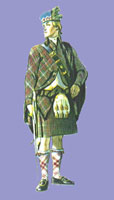 |
The expense of all this brought problems to the family and his son Aeneas Ronaldson MacDonell was forced to sell the whole estate except for the ruined castle. Two of his sons the 17 th and 18 th Chiefs emigrated to New Zealand . The 23 rd Chief is at this moment head of the house. |
Chief: Aeneas Ronald Donald MacDonell of Glengarry
Plant: Common Heath |
|
| Back to Top |
| The main line of Clan MacDougal descends from Somerled of the Isles, who died in 1164. This is a Celtic Clan and very old. Dugall eldest son of Somerled may be the person responsible for this line of ancestry. Dugals grandson was King Ewin of Argyll, in 1248. Alexander de Ergadia or Alexander of Argyll was his son and heir and he died in 1310. John of Lorne was his son and a thorn in the side to Robert the Bruce the Scottish King. A fight between The Bruce and John MacDougall gave birth to the famous “Brooch of Lorne” story in 1306. It was reported that a brooch had been torn from the Bruces shoulder during the fight. The said brooch is now in the hands of MacDougal of Dunolly. Bruce ultimately overcame the clan opposition. |
|
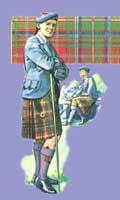 |
In 1562 a direct descendent of the MacDougall who had fought with Bruce entered the lands of Dunolly. He lived there until his death in 1598. Sir Duncan Campbell of Glenorchys daughter married Sir John of Dunolly when he succeeded to the title.
People who supported the old pretender forfeited their lands and John of Lorn was one of them. However, his lands were later returned to him.
The land is still held by the same family MacDougall of MacDougall. |
There exists several more MacDougall Clans, MacDougalls of Freugh, Garthland, Gillespick, Logan, Makerstoun and Muirtoun. Ardchattan Priory on Loch Etive is the ancestral burial place for the Clan.
The MacDougall Clan have a distinguished war record the most notable being Colonel MacDougall who while in the service of the Swedish service, defeated the Imperialists of Leignitz.
|
Chief: MacDougall of MacDougall and Donollie
Clan Seats: Donollie Castle , Oban; Gylen Castle Kerrera, Argyll.
Plant: Bell Heather |
|
| Back to Top |
| This clan is first mentioned in history through one called Dufagan Comes, and he was supposed to have been the first of the Celtic Earls of Fife. This earldom was a bit different from others and was held “by the grace of god” rather than for The King of Scots. This prevailed well into the twelfth century. Again, this was different from other Clans as it had a special type of governing body, which was known as “Law Clan MacDuff”. In 1129, Constantine second earl of Fife died and was succeeded by Gillmichel MacDuff who became the third Earl of Fife. The fifth earl of Fife was noted
for the part he played in the ransom of William the Lion in 1174.
His grandson, Malcom had two sons, his successor, Colbain and the
MacDuff who was the primary cause of John Baliol's rebellion against
Edward the first (Defeated by Bruce at the battle of Bannockburn
1314). |
|
 |
The line of the Celtic Earls of Fife ended when the eleventh earl died without having a son and left an only daughter. In 1401, David Duff of Muldavit claimed to be descended from the Earls of Fife. His descendent was William Duff, Lord Braco (1735) He was also known as Viscount MacDuff and Earl of Fife in the peerage of Ireland . The title eventually descended to Alexander was to become the sixth Earl of Fife and was created Duke of Fife in 1889. Later that same year the Duke was to be married to Princess Louise who was the eldest daughter of King Edward the Seventh. In the year 1912, his eldest daughter succeeded and became Duchess of Fife. |
Chief: Duff of Braco
Clan Seat: Duff House, Banff. Keithmore, Dufftown, Banffshire.
Plant: Oak
Memorials: Duff House Mausoleum |
|
Click below to find other Scottish Clans
|
|
Back to Top
|

